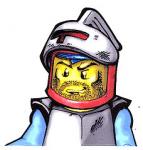In Andrei Rublev’s icon, the persons of the Holy Trinity are shown in the order in which they are confessed in the Credo. The first angel is the first person of the Trinity - God the Father; the second, middle angel is God the Son; the third angel is God the Holy Spirit. All three angels are blessing the chalice, in which lies a sacrificed calf, prepared for eating. The sacrifice of the calf signifies the Saviour’s death on the cross, while its preparation as food symbolizes the sacrament of the Eucharist. All three angels have staffs in their hand as a symbol of their divine power.
The first angel, shown at left, is vested in a blue undergarment which depicts his divine celestial nature, and a light purple outer garment which attests to the unfathomable nature and the royal dignity of this angel. Behind him and above his head towers a house, the abode of Abraham, and a sacrificial altar in front of the house. This image of the abode has a symbolic meaning: the house signifies God’s master plan for creation, while the fact that the house towers above the first angel shows him to be the head (or Father) of this creation. The same fatherly authority is seen in his entire appearance. His head is not bowed and he is looking at the other two angels. His whole demeanor - the expression on his face, the placement of his hands, the way he is sitting - all speaks of his fatherly dignity. The other two angels have their heads inclined and eyes turned toward the first angel with great attention, as though conversing with him about the salvation of mankind.
The second angel is placed in the middle of the icon. This placement is determined by the position held by the second Person within the Trinity Itself. Above his head extend the branches of an oak tree. The vestments of the second angel correspond to those in which the Saviour is usually depicted. The undergarment is a dark crimson color which symbolizes the incarnation, while the blue outer robe signifies the divinity and the celestial nature of this angel. The second angel is inclined towards the first angel, as though deep in conversation. The tree behind him serves as a reminder of the tree of life that was standing in Eden, and of the cross.
The angel on the right is the third Person of the Trinity - the Holy Spirit. His light blue undergarment and smoky-green outer garment represent heaven and earth, and signify the life-giving force of the Holy Spirit, which animates everything that exists. “By the Holy Spirit every soul lives and is elevated in purity” - sings the Church. This elevation in purity is represented in the icon by a mountain above the third angel.
Thus Andrei Rublev’s icon, while being an unsurpassed work of iconography, is first and foremost a “theology in color,” which instructs us in all that concerns the revelation of the triune God and the three Persons of the Holy Trinity.





1 comment:
This is also an interesting comment about the icon;
The invisible circle
"If we take a look at the Trinity of Rublev we see there is an invisible circle which forms a movement from the Father (on the left) toward the Son (in the center) and the movement of both Son and Spirit (right) toward the Father. If we take a mathematical compass and anchor it in the in the center of the icon, we discover that the three figures can be enclosed in a circle. However, since this circle is only an invisible one, the figures are not closed in upon themselves. There is openness. The circle becomes a movement in which the one who prays is lifted up and held secure.
We are invited to enter the circle wherein lies the House of Love, because the Father, Son, and Holy Spirit have no boundaries and embrace everyone who wishes to dwell there. When we contemplate this icon we come to see that all engagements in this world can bear fruit only when they take place within this divine circle of God’s love."
http://www.catholic.com/thisrock/2000/0005fea3.asp
Post a Comment